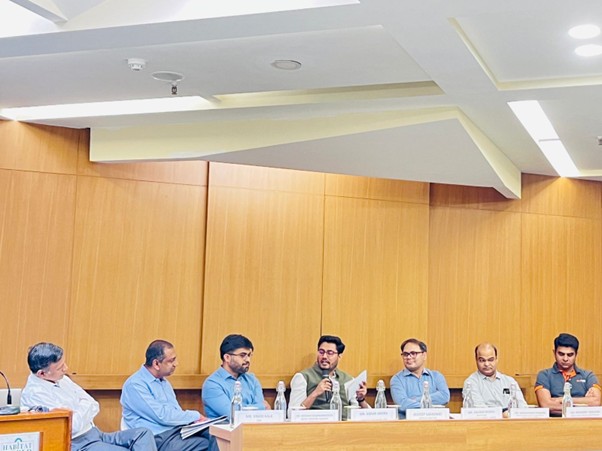
On April 18, 2024, key stakeholders from across the cement industry, policymakers, and sustainability experts gathered at Casuarina Hall, India Habitat Centre, New Delhi, for a crucial discussion on deep electrification pathways to reduce emissions from cement manufacturing in India. The event brought together industry leaders, technology pioneers, and financial experts to explore innovative solutions for decarbonising one of the country’s most emission-intensive sectors.
Cement production plays a vital role in India’s infrastructure and economic growth, yet it remains a high-carbon industry, largely dependent on fossil fuels. As India progresses towards its climate commitments, the sector faces the pressing challenge of reducing emissions while meeting growing demand. The panel discussion featured insights from industry leaders, each offering a unique perspective on tackling this challenge.
Industry Efforts Towards Net-Zero Cement
Mr Anupam Badola from Dalmia Cement shared the company’s ambitious net-zero roadmap for 2040, detailing their approach to integrating alternative fuels and new-age technology pilots. Dalmia Cement’s proactive stance demonstrates that decarbonisation is achievable with a clear vision and sustained commitment to sustainable practices.
Similarly, Mr Akhileshwar Upadhyay from Ultratech Cement emphasized the need to balance sustainability with increasing cement demand. Ultratech’s strategy includes reducing the clinker factor, a key contributor to carbon emissions, while expanding alternative fuel substitution to decrease reliance on traditional fossil fuels.
Technology and Financial Enablers for Decarbonisation
While green hydrogen holds promise as a future energy source for cement manufacturing, Mr Krishnamoorthy Sivaram cautioned that its large-scale adoption would only materialise after it is well-established in other industries. He also stressed the importance of clear financial roadmaps for debt providers, urging the creation of a well-defined taxonomy for the cement sector to facilitate financing for clean energy investments.
On the logistics front, Mr. Paramjeet Chauhan from EVage Motors pointed out the early-stage nature of electrification in cement transportation, emphasising the need for supportive policies such as lower interest rates on financing to accelerate the adoption of electric and zero-emission vehicles in cement logistics.
Financial and Regulatory Pathways to a Low-Carbon Future
The economic feasibility of emerging decarbonisation technologies remains a significant challenge. Mr Vinod K Kala, CEO of Emergent Ventures India, underscored the financial uncertainties surrounding key technologies and suggested innovative market-driven solutions. He proposed a higher carbon pricing model and variable GST rates for cement products based on their carbon footprint as potential strategies to incentivise the industry’s transition to low-emission cement production.
Meanwhile, Mr Karan Arora, Energy Advisor at GIZ, called for stricter enforcement of the Perform, Achieve, and Trade (PAT) scheme to encourage cement manufacturers to actively invest in emerging clean technologies. Strengthening policy frameworks, he argued, would provide the necessary push for large-scale industrial transformation.
A Path Forward
The discussion underscored a collective industry-wide realisation that decarbonisation is no longer a choice but a necessity. As companies experiment with alternative fuels, explore green hydrogen, and embrace digitalisation, the role of policy enablers, financial incentives, and regulatory clarity becomes even more critical.
The event reaffirmed that deep electrification and emissions reduction in the cement sector require a multi-pronged approach—blending technological innovation, financial restructuring, and policy reinforcement. The insights shared by industry leaders laid a strong foundation for future collaborations, pushing India’s cement sector toward a more sustainable and climate-resilient future.




